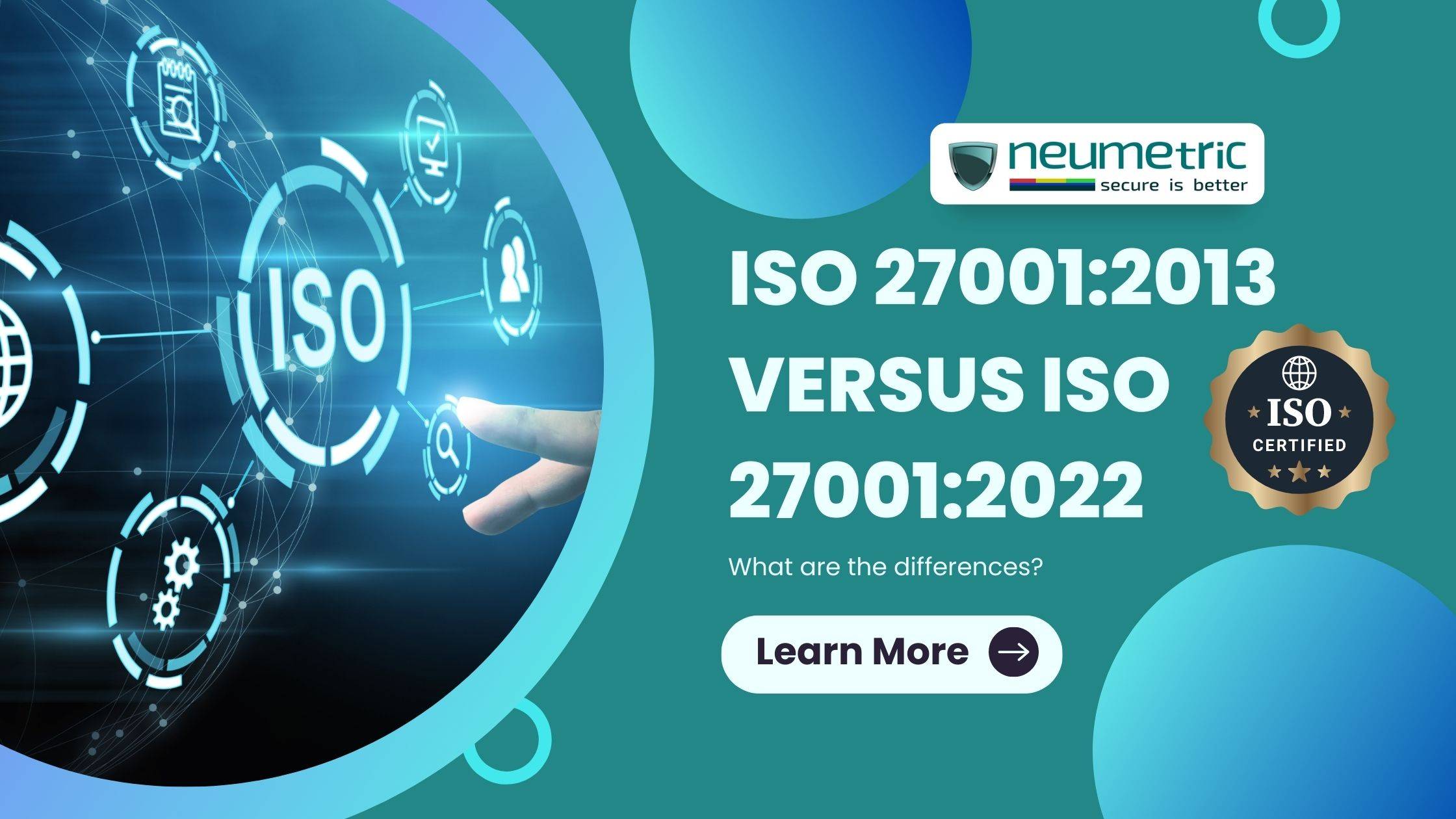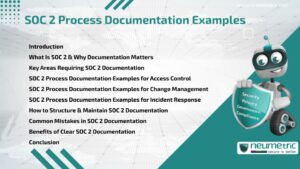Table of Contents
ToggleIntroduction:
ISO 27001 is an internationally recognized standard for Information Security Management Systems [ISMS]. It provides a framework for organizations to establish, implement, maintain & continually improve their information security practices. The standard helps organizations protect their sensitive information & manage risks effectively.
The transition from ISO 27001:2013 to ISO 27001:2022 brings about several important changes & updates. This Journal aims to compare & highlight these differences, ensuring organizations understand the key modifications & their implications.
ISO 27001:2022 adopts consistent terminology with other standards, enhancing clarity & compatibility across different management systems. Another significant update is the emphasis on understanding the organization’s context in relation to information security. ISO 27001:2022 emphasizes the need for organizations to identify & comprehend internal & external factors that may impact their information security practices.
ISO 27001:2022 also enhances the risk assessment & treatment process. The standard introduces the concept of “risk-based thinking,” which requires organizations to adopt a proactive approach to risk management. It emphasizes the importance of considering risks & opportunities when establishing & implementing information security controls. This approach ensures that organizations can identify & address emerging threats & vulnerabilities, staying ahead of potential security incidents.
Overview of ISO 27001:2013
ISO 27001:2013 is an internationally recognized standard for Information Security Management Systems [ISMS]. It provides a framework for organizations to establish, implement, maintain & continually improve their information security practices. The standard helps organizations protect their sensitive information & manage risks effectively.
The key components of ISO 27001:2013 include a comprehensive set of requirements & guidelines for establishing an ISMS. The standard emphasizes a risk-based approach to information security, ensuring that organizations identify & address potential threats & vulnerabilities. It provides guidance on implementing controls & measures to protect information assets, including policies, procedures & technical safeguards.
ISO 27001:2013 follows a structured approach known as the Plan-Do-Check-Act [PDCA] cycle. This cycle involves four main stages: planning, implementation, monitoring & review. Organizations are required to establish an Information Security Policy, conduct risk assessments, define objectives & controls, implement the necessary measures, monitor performance, conduct internal audits & undergo management reviews.
Implementing ISO 27001:2013 brings several benefits to organizations. It helps improve the Confidentiality, Integrity & Availability [CIA] of information, reducing the risk of data breaches & unauthorized access. It enhances customer confidence, demonstrating a commitment to information security & privacy.
Introduction to ISO 27001:2022
ISO 27001:2022 is the updated version of the internationally recognized standard for Information Security Management Systems [ISMS]. It provides organizations with a framework to establish, implement, maintain & continually improve their information security practices. The new version introduces several changes & updates to ensure the standard remains relevant & effective in the face of evolving cybersecurity threats & technological advancements.
The main objectives of ISO 27001:2022 are to enhance the standard’s compatibility with other management system standards & to provide organizations with a more robust & adaptable framework for information security management. The revision aims to align ISO 27001 with the High-Level Structure [HLS] used in other ISO Management System Standards, such as ISO 9001 & ISO 14001.
One of the significant focuses of ISO 27001:2022 is the incorporation of emerging trends & technologies. The standard recognizes the growing importance of areas such as Cloud Computing, Internet of Things [IoT], Artificial Intelligence [AI] & Data Analytics in modern business operations.
Key Changes & Updates:
ISO 27001:2022 introduces significant changes & updates to the standard. One of the notable changes is the structural alignment with the High-Level Structure [HLS] used in other ISO management system standards. This alignment facilitates easier integration with other management systems, allowing organizations to streamline their processes & achieve better synergy between different systems.
In terms of clause organization & content, ISO 27001:2022 brings modifications to improve clarity & effectiveness. It includes a dedicated clause on the context of the organization, emphasizing the need to understand internal & external factors that may impact information security. This requirement helps organizations identify risks & develop appropriate controls based on their specific operational environment.
The leadership requirements are expanded in ISO 27001:2022. The involvement & commitment of top management in driving information security initiatives are emphasized. This includes setting clear objectives, allocating necessary resources & ensuring continual improvement of the Information Security Management Systems [ISMS].
The risk assessment & treatment process is enhanced in ISO 27001:2022. The standard places a stronger emphasis on risk-based thinking, which requires organizations to proactively identify & manage risks. It encourages organizations to consider risks & opportunities when establishing & implementing information security controls.
ISO 27001:2022 also introduces new requirements to address emerging trends & technologies. It emphasizes the need to consider the impact of cloud computing, Internet of Things [IoT], Artificial Intelligence & Data Analytics on information security. The standard also highlights the importance of supply chain security & the incorporation of a risk-based approach throughout the ISMS.
Risk-Based Approach & Context of the Organisation:
ISO 27001:2022 places a strong emphasis on risk management & the context of the organization. The risk-based approach is a fundamental principle of the standard, requiring organizations to proactively identify, assess & treat information security risks. This approach ensures that organizations allocate resources & implement controls based on the level of risk, focusing efforts where they are most needed.
The context of the organization is another key aspect in ISO 27001:2022. It emphasizes the need for organizations to understand their internal & external environment, including the needs & expectations of stakeholders. This broader organizational context helps in identifying risks & opportunities specific to the organization. By considering stakeholder’s needs, organizations can develop an Information Security Management Systems [ISMS] that aligns with the organization’s strategic goals & objectives, ensuring that information security supports the overall business objectives.
The enhanced focus on risk management & the context of the organization in ISO 27001:2022 has several implications. Firstly, it promotes a more targeted & efficient allocation of resources, as organizations prioritize areas of higher risk. It also enables organizations to take a proactive approach in addressing emerging threats & vulnerabilities, staying resilient in the face of the evolving cybersecurity landscape.
Overall, the risk-based approach & consideration of the organization’s context in ISO 27001:2022 provide a framework for organizations to manage information security risks effectively & align information security practices with the organization’s strategic goals & stakeholders’ needs.
Addressing Emerging Technologies & Trends:
ISO 27001:2022 acknowledges the impact of emerging technologies & trends on information security & incorporates measures to address associated risks. For example, the standard recognizes the significance of cloud computing, Internet of Things [IoT] & mobile devices. Organizations are required to assess & manage the risks associated with these technologies effectively.
Cloud Computing brings unique security challenges, such as data privacy & confidentiality concerns. ISO 27001:2022 encourages organizations to evaluate cloud service providers, establish clear roles & responsibilities & implement appropriate controls to ensure the secure use of cloud services.
The proliferation of IoT devices poses additional risks, including data breaches & unauthorized access. ISO 27001:2022 emphasizes the need to identify & address these risks through proper risk assessments, secure configuration & regular monitoring of IoT devices.
Remote work & the increased use of mobile devices have also become prominent. ISO 27001:2022 emphasizes the importance of securing remote access & ensuring the protection of sensitive information on mobile devices. Organizations are required to implement appropriate controls, such as secure network connections, strong authentication mechanisms & encryption.
Process Approach & Performance Evaluation:
ISO 27001:2022 enhances the process approach & performance evaluation within the Information Security Management Systems [ISMS]. The standard emphasizes the importance of a systematic & structured approach to managing information security processes.
The process approach encourages organizations to define & document their information security processes, including the identification of inputs, activities & outputs. This approach enables organizations to have a clear understanding of how information security processes are interconnected & how they contribute to the overall effectiveness of the ISMS.
ISO 27001:2022 introduces new requirements related to measurement, monitoring & analysis. Organizations are expected to establish performance indicators to evaluate the effectiveness of their information security controls. Regular monitoring & analysis of these indicators enable organizations to identify potential weaknesses, deviations or emerging risks & take appropriate actions to address them.
Continual improvement is a key focus in ISO 27001:2022. The standard emphasizes the need for organizations to continually review & enhance their ISMS to adapt to changing circumstances & emerging threats. This includes establishing processes for corrective actions & preventive actions to address identified non-conformities or potential vulnerabilities.
Transitioning from ISO 27001:2013 to ISO 27001:2022
For organizations currently certified under ISO 27001:2013, transitioning to ISO 27001:2022 requires careful planning & consideration. Here are some key considerations & steps to facilitate a smooth transition:
- Familiarize yourself with the changes: Begin by understanding the key differences between ISO 27001:2013 & ISO 27001:2022. Review the updated standard, paying close attention to the structural changes, modified clause organization content & new requirements.
- Perform gap analysis: Conduct a gap analysis to assess your current ISMS against the updated requirements of ISO 27001:2022. Identify areas where changes or enhancements are needed to align with the new standard.
- Develop a transition plan: Based on the gap analysis, create a comprehensive transition plan that outlines the necessary actions, resources required & timelines for implementation. Prioritize the areas that need immediate attention & allocate appropriate resources accordingly.
- Update documentation & procedures: Review & update your documentation, including Policies, Procedures & Risk Assessments, to reflect the changes in ISO 27001:2022. Ensure that your ISMS documentation accurately represents your organization’s context & addresses the new requirements.
- Employee awareness & training: Educate your employees about the changes in ISO 27001:2022 & provide training on updated processes & procedures. Ensure that they understand their roles & responsibilities in implementing & maintaining the revised ISMS.
- Internal audit & management review: Conduct an internal audit to evaluate the effectiveness of the transition & identify any gaps or non-conformities. Use the findings to implement corrective actions & continuously improve your ISMS. Schedule management reviews to assess the overall performance of the ISMS & make strategic decisions for improvement.
Conclusion:
In Conclusion, the transition from ISO 27001:2013 to ISO 27001:2022 brings several key differences & updates. ISO 27001:2022 aligns with the High-Level Structure [HLS], incorporates a stronger focus on risk-based thinking, emphasizes the context of the organization & introduces requirements related to emerging technologies & trends. It also enhances the process approach, performance evaluation & continual improvement aspects.
Staying updated with the latest version of ISO 27001 is essential for organizations to ensure the continued effectiveness & relevance of their Information Security Management Systems [ISMS]. By transitioning to ISO 27001:2022, organizations can benefit from the enhanced framework, improved compatibility with other management systems & a more proactive & adaptive approach to information security.
It is important for organizations to evaluate their current implementation against the updated requirements of ISO 27001:2022. Conducting a thorough gap analysis, updating documentation & procedures, providing employee awareness & training & implementing necessary changes are vital for a seamless transition.
FAQs:
What is the difference between ISO 27001 2013 & 2022?
The main differences between ISO 27001:2013 & ISO 27001:2022 include structural alignment with other ISO management system standards, an enhanced focus on risk-based thinking, expanded leadership requirements & updated requirements to address emerging technologies & trends.
Is ISO 27001 2013 still valid?
ISO 27001:2013 is still valid, but organizations are encouraged to transition to the latest version, ISO 27001:2022, for improved compatibility & effectiveness.
What is the difference between ISO 27001 2013 & ISO 27002?
ISO 27001:2013 & ISO 27002 are different standards. ISO 27001 provides a framework for establishing an Information Security Management Systems [ISMS], while ISO 27002 provides guidance for implementing specific security controls.
Is ISO 27001 the latest version?
ISO 27001:2022 is the latest version of the ISO 27001 Standard.





